Hyundai was one of the first brands officially announced as a CarPlay partner back in 2014, and the feature is now available across pretty much all of the carmaker's lineup. I recently spent some time with CarPlay and Hyundai's native infotainment system in the redesigned 2020 Hyundai Sonata, and I've been impressed with not only Hyundai's CarPlay implementation but also just how much technology in general Hyundai has managed to include in the Sonata for its price.

The 2020 Sonata starts at $23,600 and is available in four trim levels, topping out with the Limited trim at nearly $34,000 plus destination charges. My test vehicle was the high-end Limited trim, which comes with all of the bells and whistles Hyundai offers without any additional packages needed, with the exception of a $300 upcharge for the Quartz White paint and optional accessories like floor mats and cargo customization. A traditional hybrid version of the redesigned Sonata with an available solar-panel roof should be available in the coming months.
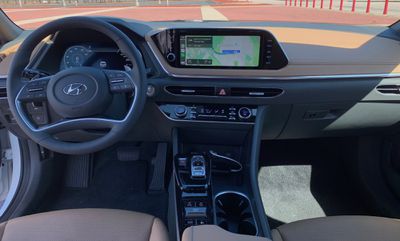
Technology and Safety Features
The 2020 Sonata is packed with technology, offering nearly every popular safety feature, including many of them even on the base SE trim. Forward collision avoidance with pedestrian detection, lane keep assist, lane follow assist, driver attention warning, and smart cruise with stop and go are standard on all trims, while SEL and higher trims add blind spot collision avoidance and rear cross traffic avoidance.
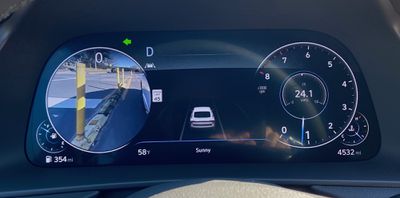
At the top end, the Limited trim includes parking collision avoidance, highway drive assist (which is an option on the SEL Plus trim), and a very convenient blind view monitor that pops up a video feed of your blind spot anytime you activate the turn signal. The video appears right in the gauge cluster and makes it very easy to check exactly what's next to your vehicle, a significant step up from the traditional blind spot monitor that only illuminates a light if an object is detected.
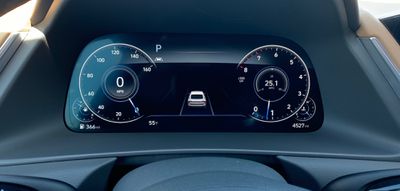
Speaking of the gauge cluster, the Limited and SEL Plus trims come with a nice all-digital 12.3-inch screen, and it's available as part of the convenience package on the SEL trim. The Limited trim also includes a head-up display for even more information available at a glance without needing to take your eyes off the road.
And of course, there's the Limited-only "Smart Park" feature made famous with a Super Bowl ad this year, which lets you remote start the car and move it slowly forward or backward without you even needing to be in the car. Hyundai markets it as a feature for letting you get the car in or out of tight parking spaces, and while it feels like mostly a gimmick to me, it's another sign of the semi-autonomous technologies that continue to roll out across many car manufacturers.
Infotainment
When it comes to infotainment, the base Sonata comes with an 8-inch screen, but my Limited trim includes a larger 10.25-inch widescreen display with built-in navigation. The larger display is also available on the stepped-down SEL Plus trim as an option if you add the $2,750 tech package that also includes a sunroof, LED interior lights, premium Bose audio, and highway drive assist. CarPlay and Android Auto are standard on all trims, regardless of display size.
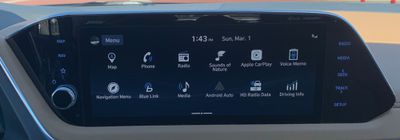
Hyundai has rolled out a revamped infotainment in the 2020 Sonata, and it's a massive improvement. It offers a clean look with layouts and designs that will feel familiar to any smartphone user. Customizability is embraced throughout the system, with the ability to edit the home screen icon and widget layouts, and this customizability extends throughout the vehicle systems with a vast array of options accessible through the infotainment system.

Similar to CarPlay, the Hyundai infotainment system offers a couple of different home screen views, starting with a dashboard-style screen that lets you customize widgets such as navigation, audio, weather, and more. A swipe on the screen switches over to an icon-based home screen that gives you access to all of the system functions. You'll find all of the usual functions here, including data on your driving performance, a handy app for recording voice memos, and even a "Sounds of Nature" function that lets you pipe relaxing sounds like a forest scene, sea waves, rain, or a crackling fireplace throughout the car.

There's really only one tactile hardware control, and that's the volume knob, but there are several capacitive buttons on either side of the display. You can't really find them by feel as you would be able to do with physical buttons, but at least they make it easy to jump to frequently used infotainment functions without needing to navigate through the system's UI. There's also a dedicated "star" button that can be configured to offer one-touch access to CarPlay, for example.
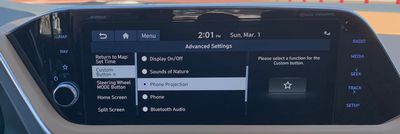
Built-in navigation is provided by HERE, and it proved to be a capable system with a solid POI database that was able to pull up nearly every destination I attempted to find. It's also easy to search by POI categories, set shortcuts for multiple frequent destinations, and select your route options.

The navigation system provides a side-by-side view with a larger screen showing your overall upcoming route and a smaller side panel with specific information for your next upcoming turn, but you can also drag over another side panel to essentially divide the widescreen display into thirds and simultaneously show other infotainment system data like audio.

CarPlay
CarPlay on the 2020 Sonata requires a wired connection, which is still very common among car manufacturers, although many are starting to move toward wireless connectivity options in their next-generation infotainment systems that are just starting to roll out.

Perhaps my favorite thing about CarPlay in the 2020 Sonata is the ability to set a user preference for widescreen or side-by-side screens. Widescreen infotainment systems are becoming more and more popular, and manufacturers have typically fallen into one of two camps when it comes to supporting CarPlay in them: let CarPlay take over the entire screen or limit it to a portion of the screen while leaving a smaller side panel to display information from the native system.

Hyundai lets the user choose, although it's not a setting you'll be able to easily switch while driving as it's managed within the settings for the connected phone.

Regardless of which option you choose, you'll see a typical CarPlay experience with interactions happening through either the expansive touchscreen or Siri. Maps in particular looks great on the widescreen, but even at the smaller size you'll have a reasonable view of what's around you.

The touchscreen is responsive in both the native system and CarPlay, and I experienced no issues with CarPlay connectivity in my testing. The capacitive buttons on either side of the display make it simple to hop out to the native system, while the customizable star button makes for one-touch access to get back into CarPlay.
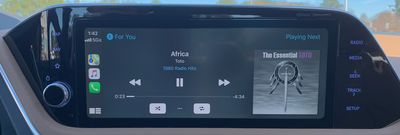
As is typical for steering wheel controls, there's a single voice control button that serves dual duty. A short press brings up the Hyundai voice system while a long press activates Siri.

Climate Controls
Despite the raft of features included in the 2020 Sonata, Hyundai has done a lot to minimize the complexity of the controls. Climate controls thankfully remain hardware-based and separate from the infotainment system, and it's a relatively clean setup that even integrates controls for the heated and ventilated front seats.

Hyundai has made fairly heavy use of space-saving switches for things like A/C mode controls, fan speeds, and drive modes, making for a simpler layout than other systems that use multiple buttons for each function.
Ports and Wireless Charging
The Sonata features a pair of USB-A ports up front on all trims, with one for data and one for charging only. A single charge-only USB-A port for rear passengers is included standard on the Limited and SEL Plus trims, while it's part of a $1200 convenience package on the SEL trim. It's not available at all on the base SE trim.
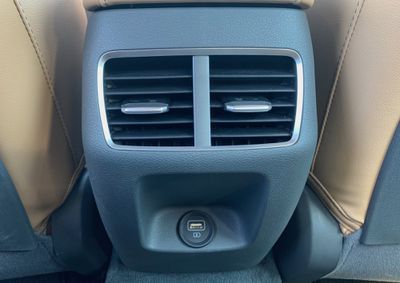
Hyundai also offers a Qi wireless phone charging on some trims of the 2020 Sonata, with the charger coming standard on the Limited trim and as an option on the SEL Plus trim. It's not available on the SEL or SE trims.
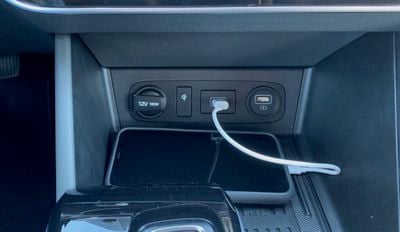
I experienced a bit of quirkiness with the charger, as it was not able to charge my iPhone 11 Pro Max with Apple's Smart Battery Case. Upon setting my phone charging pad, my phone would vibrate as if charging had started, but then it would repeat every few seconds and the charging status light above the charger would never illuminate.
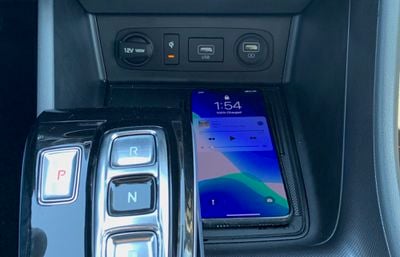
I removed the Smart Battery Case and tried with the bare phone, and charging worked fine. I also tried with an iPhone XS Max with and without the official Smart Battery Case for that model and everything worked fine.
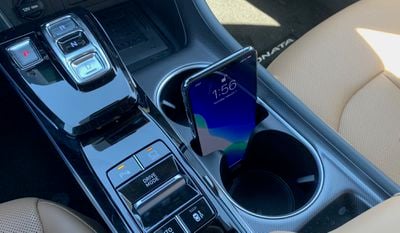
The Sonata offers another handy phone storage option, and that's a slot in the center console between the two cupholders. A phone sits upright in the slot, making it easy to grab on your way out of the car, and it's a convenient space-saving solution for holding the phone even while connected to the infotainment system for CarPlay, as long as you put the phone in upside down.
Wrap-up
The 2020 Sonata packs an impressive amount of technology for its price points, and I'm looking forward to seeing these capabilities and the revamped infotainment system make their way across the rest of the Hyundai lineup.
While I'd like to see wireless CarPlay, the wired solution works well and integrates smoothly with the new infotainment system. The spacious widescreen display available on higher trims is terrific, and I love the amount of customizability Hyundai provides, extending all the way to allowing for standard or full-screen CarPlay.
The 2020 Sonata starts at a reasonable $23,600 an maxes out at just about $34,000, even with all of that technology built in. Aside from an engine that lacks some of the pep found in similarly sized luxury cars, the Sonata in a higher-end trim feels like a much more expensive sedan than it is.






















Top Rated Comments
The 2020 Sonata hybrid will be really cool, especially with the optional solar panels on the roof.
It's why I've covered a number of different cars...CarPlay itself is a largely similar experience across cars, but there are unique aspects to how manufacturers integrate with their native infotainment systems, and even within manufacturers it varies by model and infotainment system generation.